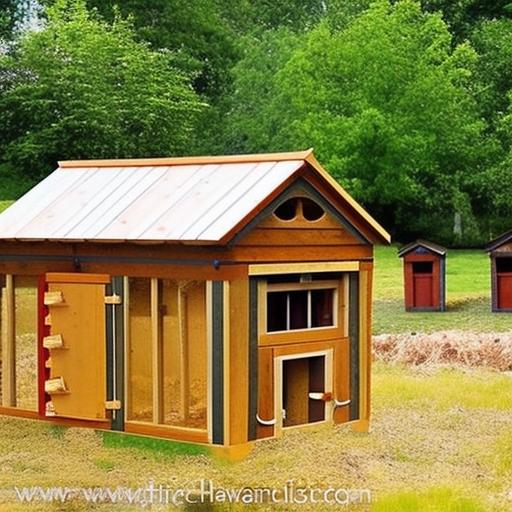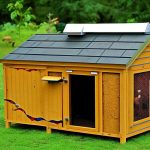Raising chickens has become increasingly popular in recent years, and for good reason. There are numerous benefits to raising chickens, from the cost savings on eggs and meat to the sustainable and eco-friendly lifestyle it promotes. Building a chicken coop for 10 hens allows you to enjoy these benefits while providing a safe and comfortable home for your feathered friends.
One of the main advantages of raising chickens is the cost savings on eggs and meat. By having your own flock, you can have a constant supply of fresh, organic eggs without having to rely on store-bought options. Additionally, if you choose to raise chickens for meat, you can save money by avoiding the high prices of store-bought poultry.
Raising chickens also promotes a sustainable and eco-friendly lifestyle. Chickens are excellent at recycling kitchen scraps and garden waste, turning them into nutrient-rich compost for your garden. They also provide natural pest control by eating insects and other pests that can damage your plants. By raising chickens, you are reducing your carbon footprint and living a more self-sufficient lifestyle.
Choosing the Right Location for Your Chicken Coop
When choosing the location for your chicken coop, there are several factors to consider. First and foremost, you need to ensure that you have enough space to accommodate the coop and allow for easy access for cleaning and maintenance. The coop should also be situated in an area that receives ample sunlight throughout the day.
Drainage is another important consideration when selecting the location for your chicken coop. You want to avoid areas that are prone to flooding or have poor drainage, as this can lead to a damp and unsanitary environment for your hens. Additionally, accessibility is key – you want to choose a location that is easily accessible for feeding, watering, and collecting eggs.
Some tips for selecting the best spot for your coop include:
– Choosing a location that is close to your house or garden for convenience.
– Avoiding areas with heavy foot traffic or noise, as this can stress out your chickens.
– Ensuring that the coop is situated away from any potential predators, such as raccoons or foxes.
– Considering the prevailing winds and positioning the coop to provide protection from harsh weather conditions.
Designing Your Coop: Size, Shape, and Materials
When designing your chicken coop for 10 hens, it is important to determine the appropriate size to ensure that your chickens have enough space to move around comfortably. As a general rule of thumb, each chicken should have at least 4 square feet of indoor space and 10 square feet of outdoor space. This means that for 10 hens, you will need a coop that is at least 40 square feet in size.
There are many popular coop designs and styles to choose from, ranging from simple and functional to elaborate and decorative. Some common designs include A-frame coops, hoop coops, and chicken tractors. The shape of your coop will depend on your personal preferences and the available space in your backyard.
When it comes to materials, it is important to choose ones that are durable and safe for your chickens. The walls should be made of sturdy materials such as plywood or metal siding, while the roof should be made of a waterproof material such as corrugated metal or asphalt shingles. The flooring can be made of concrete, wood, or wire mesh, depending on your preferences and budget.
Building the Foundation and Framing the Structure
Building a sturdy foundation is crucial for the structural integrity of your chicken coop. The foundation should be level and made of materials that can withstand the weight of the coop and its occupants. Concrete is a popular choice for foundations as it provides stability and durability.
Once the foundation is in place, you can begin framing the walls and roof of your coop. The walls should be framed using 2×4 lumber, with studs placed every 16 inches for added strength. The roof can be framed using trusses or rafters, depending on the design of your coop.
When framing the structure, it is important to ensure that everything is square and level. This will help prevent any issues with the doors and windows not fitting properly. It is also a good idea to reinforce the corners and joints with metal brackets or screws for added stability.
Installing Windows, Doors, and Ventilation
Proper ventilation is essential for the health and well-being of your chickens. Good ventilation helps remove excess moisture, ammonia, and odors from the coop, preventing respiratory issues and other health problems. It also helps regulate the temperature inside the coop, keeping it cool in the summer and warm in the winter.
When installing windows in your chicken coop, it is important to choose ones that can be opened and closed to allow for proper airflow. Windows should be placed high up on the walls to prevent drafts and protect against predators. Additionally, windows should be covered with wire mesh to prevent pests from entering the coop.
Doors are another important feature of your chicken coop. They should be large enough to allow easy access for cleaning and maintenance, as well as for your chickens to enter and exit the coop. It is a good idea to install a ramp or ladder to help your chickens get in and out of the coop more easily.
Adding Nesting Boxes and Roosts
Nesting boxes provide a safe and comfortable place for your hens to lay their eggs. They should be dark, quiet, and secluded to encourage your chickens to use them. The size of the nesting boxes will depend on the breed of your chickens, but as a general rule of thumb, each nesting box should be at least 12×12 inches in size.
Roosts are essential for your chickens to rest and sleep. They should be placed higher than the nesting boxes to prevent your chickens from soiling them. The size of the roosts will depend on the size of your chickens, but as a general rule of thumb, each roost should be at least 2 inches wide.
When designing and building nesting boxes and roosts, it is important to ensure that they are easily accessible for cleaning and maintenance. They should also be made of materials that are easy to clean and disinfect, such as wood or plastic.
Choosing the Right Feeders and Waterers
Choosing the right feeders and waterers is important for ensuring that your chickens have access to fresh food and water at all times. There are several types of feeders and waterers to choose from, including trough feeders, hanging feeders, and automatic feeders.
Trough feeders are a popular choice as they can hold a large amount of feed and are easy to refill. Hanging feeders are another option, especially if you have limited space in your coop. Automatic feeders are a convenient option as they can dispense food at set intervals, ensuring that your chickens always have access to food.
Waterers should be designed to prevent spillage and contamination. There are several types of waterers available, including gravity-fed waterers, nipple waterers, and automatic waterers. Gravity-fed waterers are a simple and cost-effective option, while nipple waterers and automatic waterers provide a more consistent supply of fresh water.
Proper placement of feeders and waterers is important to prevent contamination and spillage. They should be placed at a height that is comfortable for your chickens to reach, but not too low that they can scratch bedding into them. It is also important to regularly clean and sanitize feeders and waterers to prevent the spread of disease.
Installing Electrical and Lighting Systems
Adding electrical and lighting systems to your chicken coop can provide several benefits. Electrical systems can power heaters, fans, and automatic door openers, making it easier to regulate the temperature inside the coop. Lighting systems can help extend the daylight hours during the winter months, encouraging your chickens to continue laying eggs.
When installing electrical systems, it is important to ensure that they are installed by a qualified electrician to prevent any safety hazards. All wiring should be properly insulated and protected from moisture. It is also a good idea to install ground fault circuit interrupters (GFCIs) to prevent electrical shocks.
Lighting systems should be designed to mimic natural daylight. LED lights are a popular choice as they are energy-efficient and long-lasting. They should be placed high up in the coop and angled downwards to provide even lighting throughout the space.
Flooring, Insulation, and Bedding Options
Choosing the right flooring and insulation materials is important for keeping your chicken coop clean and dry. The flooring should be easy to clean and disinfect, as well as provide good drainage. Concrete is a popular choice for flooring as it is durable and easy to clean.
Insulation is important for regulating the temperature inside the coop. It helps keep the coop warm in the winter and cool in the summer. There are several insulation materials to choose from, including fiberglass, foam board, and reflective insulation. The type of insulation you choose will depend on your climate and personal preferences.
Bedding is essential for providing comfort and hygiene for your chickens. There are several bedding options available, including straw, wood shavings, and shredded paper. The bedding should be changed regularly to prevent the buildup of ammonia and bacteria.
Maintaining Your Chicken Coop: Cleaning, Pest Control, and Health Checks
Regular cleaning and maintenance are essential for keeping your chicken coop in good condition and preventing the spread of disease. The coop should be cleaned at least once a week, with the bedding being replaced and the surfaces being disinfected. It is also important to regularly check for any signs of pests or damage.
Pest control is another important aspect of maintaining your chicken coop. Common pests that can infest chicken coops include mites, lice, and rodents. Regularly inspecting your coop for signs of pests and taking appropriate measures to control them is crucial for the health and well-being of your chickens.
Health checks should be conducted regularly to ensure that your chickens are in good health. This includes checking for any signs of illness or injury, as well as monitoring their behavior and egg production. If you notice any abnormalities, it is important to seek veterinary care as soon as possible.
Enjoying the Fruits of Your Labor with Happy, Healthy Hens
Building a chicken coop for 10 hens is a rewarding and fulfilling project that allows you to enjoy the benefits of raising chickens while providing a safe and comfortable home for your feathered friends. By following the tips and guidelines outlined in this article, you can create a well-designed coop that meets the needs of your chickens and promotes their health and well-being.
Raising chickens in a well-designed coop not only provides you with a constant supply of fresh eggs and meat but also promotes a sustainable and eco-friendly lifestyle. By recycling kitchen scraps and garden waste, chickens help reduce waste and provide natural pest control. They also provide companionship and entertainment, making them a valuable addition to any backyard.
So why wait? Start building your own chicken coop today and enjoy the fruits of your labor with happy, healthy hens. With proper planning, design, and maintenance, you can create a safe and comfortable home for your chickens while enjoying the many benefits that come with raising them.
Meet Walter, the feathered-friend fanatic of Florida! Nestled in the sunshine state, Walter struts through life with his feathered companions, clucking his way to happiness. With a coop that’s fancier than a five-star hotel, he’s the Don Juan of the chicken world. When he’s not teaching his hens to do the cha-cha, you’ll find him in a heated debate with his prized rooster, Sir Clucks-a-Lot. Walter’s poultry passion is no yolk; he’s the sunny-side-up guy you never knew you needed in your flock of friends!








